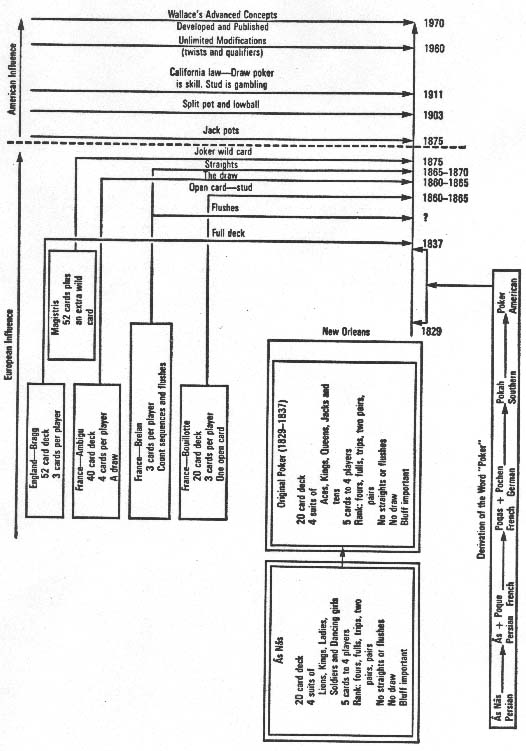
The memoirs of an English actor (Joseph Crowell) touring America in 1829 described a game being played in New Orleans in which each player received five cards and made bets--then whoever held the highest combination of cards won all bets. Mr. Crowell was probably describing the earliest form of poker or its immediate predecessor, the Persian game of Âs.
The first direct reference to poker was found in Jonathan H. Green's book, An Exposure of the Arts and Miseries of Gambling (G. B. Zieber, Philadelphia, 1843). Green described poker games on a steamer running between New Orleans and Louisville. His book indicated that poker began in New Orleans about 1830.
Research on the evolution of poker (outlined on p. 277) revealed that poker descended directly from the Persian game of Âs Nas and not, as commonly believed, from the French game of Poque, the German game of Pochen, or the English game of Bragg. But those and other European games soon exerted their influence on the original game of poker, as shown in the following two diagrams on the derivation and evolution of poker.
Sailors from Persia taught the French settlers in New Orleans the gambling card game Âs, which was derived from the ancient Persian game of Âs Nas. The Frenchmen would bet by saying, for example, "I poque for a dollar," and would call by saying, "I poque against you for two dollars." Those were the betting expressions used in their game of Poque, a three-card game first played by commoners in France and then by Frenchmen in America as early as 1803. Poque was similar to Bouillotte, a card game popular with the aristocrats in France just prior to the French Revolution of 1789.
Combining the words "Âs" and "Poque," the game became known as "Poqas." Then, influenced by the German bluff game of Pochen and the southern accent, the pronunciation of "Poqas" became "Pokah." Under Yankee influence, the pronunciation finally became "Poker."
Poker moved from New Orleans by steamboat up the Mississippi and Ohio rivers. From the river towns, the game spread east by the new railroad and west by covered wagons. Between 1834 and 1837, the full fifty-two-card deck replaced the original twenty-card deck. Soon after that, the flush was introduced. During the Civil War, modifications such as open cards (stud poker), the draw, and the straight became popular. When the joker was introduced as a wild card in 1875, the European influence of poker ended. Further development of the game was essentially American.
Jackpot poker (draw poker requiring both an ante and a pair of jacks or better to open) began about 1875. Split-pot and lowball poker started around 1903. Two Missouri assemblymen (Coran and Lyles) introduced a bill to the state legislature in 1909 to control and license poker players in order to prevent "millions of dollars lost annually by incompetent and foolish persons who do not know the value of a poker hand." In 1911, California's attorney general (Harold Sigel Webb) ruled that closed poker (draw poker) was skill and beyond antigambling laws . . . but open poker (stud poker) was luck and therefore illegal. That stimulated the development of new draw games and the use of wild cards. The variety of poker games grew steadily, particularly during the First and Second World Wars. In the 1960s, poker variations further developed with innovations such as twists (extra draws) and qualifiers (minimum hands to win).
In 1968, Wallace's Advanced Concepts of Poker was first published. By 1972, the publication had become the largest-selling poker book in the world. The Advanced Concepts of Poker fully identified for the first time the potentially ruthless, manipulative, but highly profitable nature of poker. In addition, the characteristics of consistent winners, and chronic losers were identified. Also identified for the first time were three different kinds of odds, the effects of the betting pace versus the betting stakes, the advantages of aggressive betting, and the advantages gained by the good player when complex and fast-paced games were played. And most important, the Advanced Concepts of Poker clearly identified the differences between the financially profitable good poker and financially destructive gambling as well as the differences between winners and losers.


Disclaimer - Copyright - Contact
Online: buildfreedom.org | terrorcrat.com / terroristbureaucrat.com